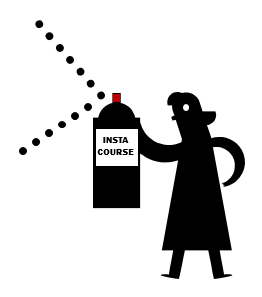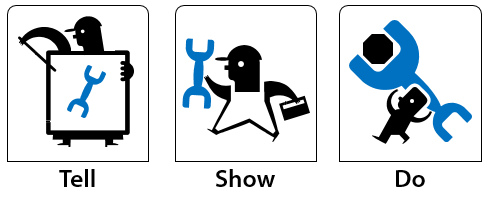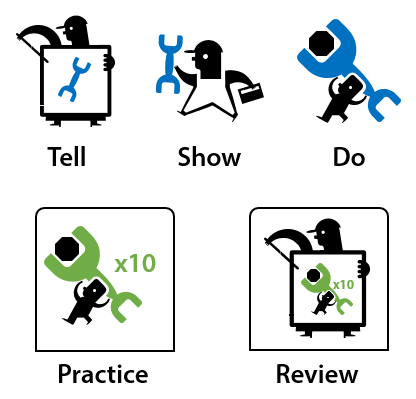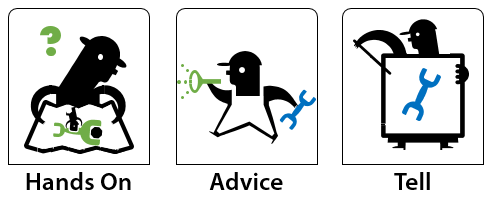Instructional Techniques for Building Effective Online Training |  |
| Instructional Techniques for Building Effective Online Training Posted: 08 Jul 2014 12:31 AM PDT
Effective online training involves more than just sharing information. It also requires the learner practice and apply what you've taught them. Despite our best efforts many online courses are still mostly linear. As I’ve mentioned before, that’s probably fine for those annual compliance courses that aren't tied to specific performance objectives. But if you want to build courses that are effective and engaging you need to focus on sound instructional design and the activities required to learn and prove understanding. Effective Online Training Starts with the Tell, Show, & Do TechniqueA common approach to online course design is to Tell, Show, and Do. It makes sense because it covers the basics.
The Tell, Show, and Do model is a common instructional technique because it lets you build context and demonstrate the desired performance. And in the end the learner gets to practice applying what they learned. What's also good about this technique is that it nudges you away from the linear, click & read model that is so prevalent with a lot of online training. Tell, Show, Do, Practice & Review to Build Effective Online TrainingWhen I was training junior level instructional designers I liked to say "Tell, show, do! Then practice and review!" because it rhymed and was an easy mantra to remember the essential steps required in the learning process. It covers everything from providing the core information to debriefing the learning experience which is more involved than the more common Tell, Show, and Do technique above.
I like this technique better than the first one because it includes the review and debriefing. This is also a great way to structure a peer coaching process when mentors or peer coaches do a lot of the training. It gets them to do more than just show how something is to be done. Build Effective Online Training by Starting with an ActivityInstead of building context and showing them what to do, have them start by doing an activity first. I call it the HAT technique (because I needed three bullets).
This technique is effective and starts by engaging the learner. However one of the challenges with this approach is that it requires more time to think through and build effective learning activities. On top of that, many clients demand a more linear solution like the common Tell, Show, and Do technique. But by doing the activity first you get people engaged and constructing their own understanding sooner. It also helps them identify their own knowledge gaps which helps build context for the instruction you want to provide. Regardless of the technique you use, the key is to get them doing something to practice and demonstrate what they know. This will help you move past the linear information sharing and towards more effective online training.
Weekly Updates
Community Blog Posts & Tutorials
Upcoming Events & Workshops
Post written by Tom Kuhlmann Download your free 46-page ebook: The Insider's Guide to Becoming a Rapid E-Learning Pro The post Instructional Techniques for Building Effective Online Training appeared first on The Rapid eLearning Blog. |
| You are subscribed to email updates from The Rapid eLearning Blog To stop receiving these emails, you may unsubscribe now. | Email delivery powered by Google |
| Google Inc., 20 West Kinzie, Chicago IL USA 60610 | |
--
Posted By tremeex to tremeex at 7/08/2014 07:12:00 AM
--
Posted By tremeex to tremeex at 7/08/2014 07:12:00 AM
--
Posted By tremeex to tremeex at 7/08/2014 07:12:00 AM
--
Posted By tremeex to tremeex at 7/08/2014 07:12:00 AM
--
Posted By tremeex to tremeex at 7/08/2014 07:12:00 AM
--
Posted By tremeex to tremeex at 7/08/2014 07:12:00 AM
--
Posted By tremeex to tremeex at 7/08/2014 07:12:00 AM
--
Posted By tremeex to tremeex at 7/08/2014 07:12:00 AM
--
Posted By tremeex to tremeex at 7/08/2014 07:12:00 AM
--
Posted By tremeex to tremeex at 7/08/2014 07:12:00 AM
--
Posted By tremeex to tremeex at 7/08/2014 07:12:00 AM
--
Posted By tremeex to tremeex at 7/08/2014 07:12:00 AM
--
Posted By tremeex to tremeex at 7/08/2014 07:13:00 AM
--
Posted By tremeex to tremeex at 7/08/2014 07:13:00 AM
--
Posted By tremeex to tremeex at 7/08/2014 07:13:00 AM
--
Posted By tremeex to tremeex at 7/08/2014 07:13:00 AM
--
Posted By tremeex to tremeex at 7/08/2014 07:13:00 AM
--
Posted By tremeex to tremeex at 7/08/2014 07:13:00 AM
--
Posted By tremeex to tremeex at 7/08/2014 07:13:00 AM
--
Posted By tremeex to tremeex at 7/08/2014 07:13:00 AM
--
Posted By tremeex to tremeex at 7/08/2014 07:13:00 AM
--
Posted By tremeex to tremeex at 7/08/2014 07:13:00 AM
--
Posted By tremeex to tremeex at 7/08/2014 07:13:00 AM
--
Posted By tremeex to tremeex at 7/08/2014 07:13:00 AM
--
Posted By tremeex to tremeex at 7/08/2014 07:13:00 AM
--
Posted By tremeex to tremeex at 7/08/2014 07:13:00 AM





No comments:
Post a Comment